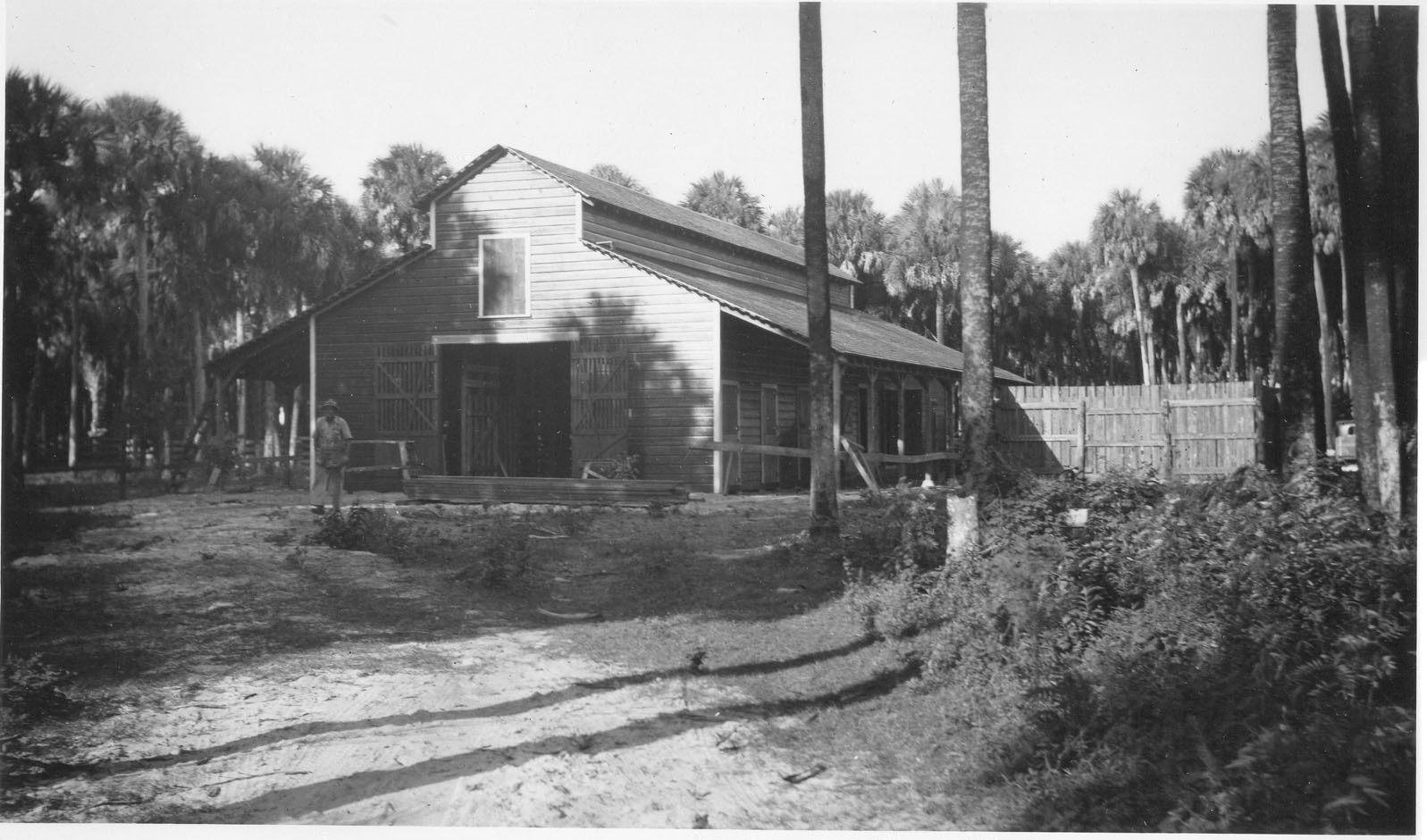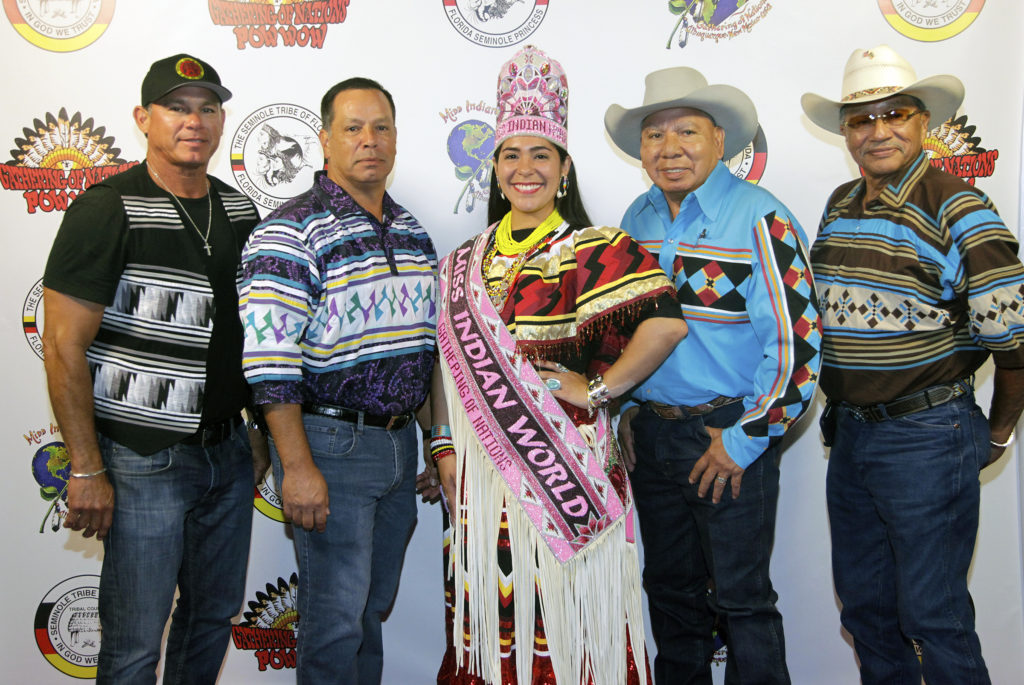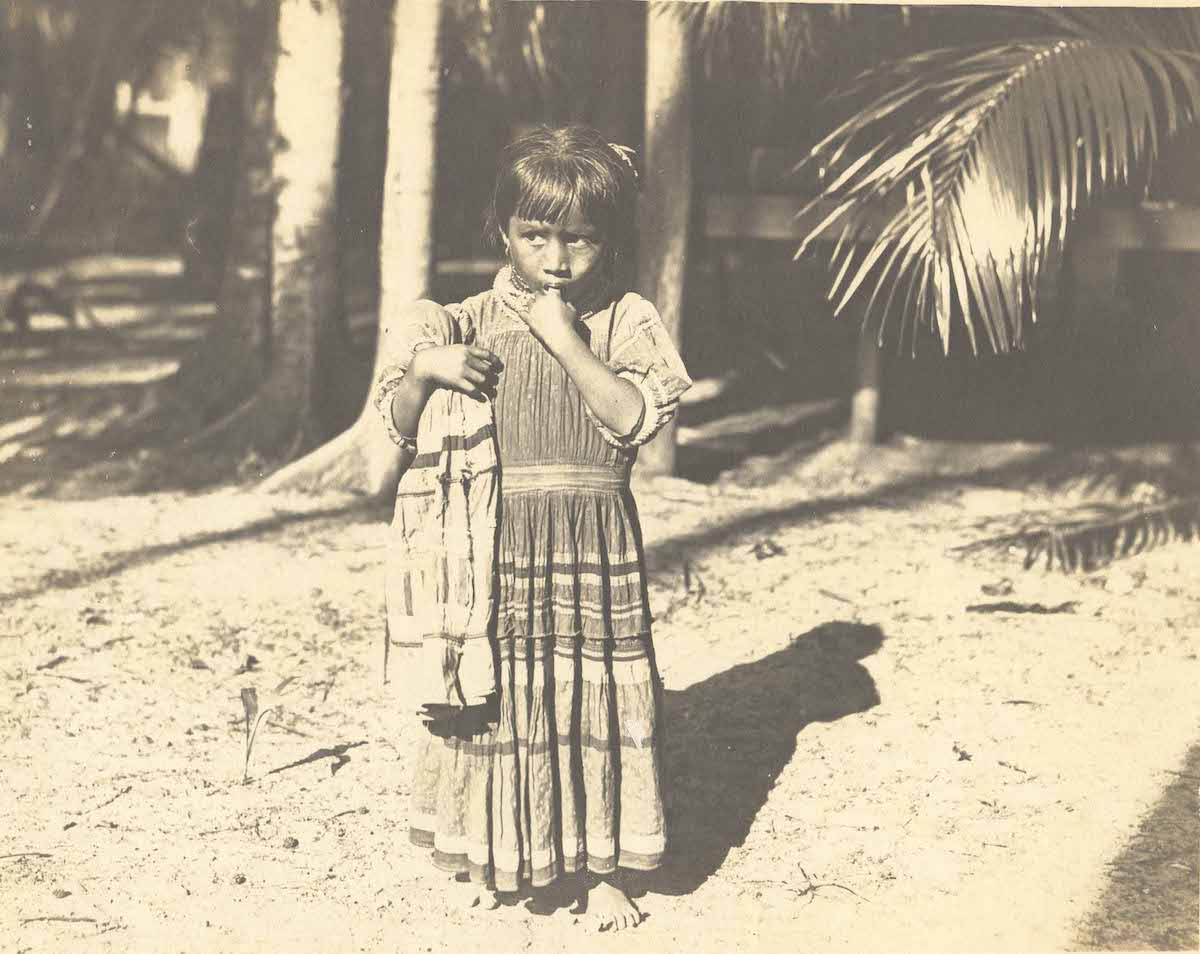
The Legacy of Red Barn and Seminole Cattle
Welcome back to our series on Seminole Spaces! In this series, we explore places and spaces important to Seminole culture, history, and tourism. This week, we are giving a closer look to the Seminole cattle industry, and in particular the legacy of the famous Red Barn. Now, Seminoles are one of the biggest names in Florida beef. But, how did that happen? Red Barn, and the concerted efforts of industrious Seminole cattlemen, helped build this legacy. Built on the Brighton Reservation in 1941, Red Barn is an important historic structure that helped launch the Seminole cattle industry into the modern era.
In our featured image this week, you can see a Boehmer photo circa 1940s, showing the Red Barn. Below, you can see a group of Seminole men standing on fence posts holding branding irons during round-up on the Big Cypress Reservation in 1949. In it, you can identify Josie Billie (marker JB, fifth from left), and Morgan Smith (marker MS, third from left), both who were instrumental in the Big Cypress cattle operation.

Steinmetz, Library of Congress
The Historic Seminole Cattle Industry
Seminoles have been involved in Florida’s cattle industry for hundreds of years. Even before they were known as Seminoles! The Spanish conquistador Ponce de Leon brought Andalusian cattle to Florida in 1521. These cattle would eventually become wild cattle – and end up birthing the famous Florida cracker cattle we have mentioned in a previous blog post. The Spanish would abandon them to the wild, leaving behind large herds of hardy cattle to the ranges of Florida by the 1700s. Ahaya, known as Cowkeeper, was the first Seminole ancestor recognized as a legendary cattle keeper by history. The Oconee leader Cowkeeper took control of Payne’s Prairie near Gainesville in the early 1700s, amassing a large herd. A fierce leader, he founded the town Cuscowilla (now Micanopy). Then, Cowkeeper took control of vast amounts of feral Spanish cattle that had been abandoned in Alachua.
By 1775, these Seminoles worked 7,000-10,000 head of cattle with trained cattle dogs. Many of the successful tactics employed by the later Florida crackers came from Seminole cattle keepers, such as the use of cattle dogs, certain open range practices, and the utilization of marshtackie horses. But, this first heyday of the Seminole cattle industry would not last. Continued aggressions between European-American settles and Seminole cattlekeepers would flourish over cattle and grazing lands. These skirmishes would be one of the catalysts for the beginning of the Seminole War period. Despite these rustlers, Seminoles around Lake Okeechobee would continue to try and work cattle at great personal risk. At the time, working cattle was such a liability that most Seminole avoided it. But, the Seminole cattle industry would not reach its previous heights until its renaissance sparked in the 1930s.
Cattle Ranching Modernizes – and so does the Seminole Tribe
In 1936, in an effort to encourage Seminole assimilation to western ideals, the U.S. Government furnished the Brighton and Dania Seminoles with starter herds. Many of these first cattle were doomed from the start, and were sick and drought-ridden. In a Seminole Tribune article about the Smith Family cattle drive in 2015, Richard Bowers reflected on this rocky start.
Bowers stated “The government took dying cattle from the dust bowl, put them on rail cars and gave them to the Seminoles. [the government] wanted us to calm down, be domesticated and have something to do. Some of the Seminoles back then took to it, liked it and went from there. They nursed them and that’s where the herd came from today. The cattle were our casino back then.” But, it was slow going. It would take decades of trial and error, blood and sweat, to get these first herds to flourish. Creative breeding programs and inventive methods would win out.
Eventually, drawing on hundreds of years of knowledge, these Seminole cattlekeepers would make this second age of Seminole cattle work despite the heavy cost. In the 1940s, government forced tick eradication and fence programs would again shake up the Tribe, who were resistant to letting go of their long hunting traditions and way of life. The Seminole Tribe created the Indian Livestock Association 1939. The Seminole Tribe had established separate cattle operation on Brighton and Big Cypress by 1944. The Central Tribal Cattle Organization supervised both endeavors. In 1974, along with other native cattlemen, the Seminole Tribe helped form the National American Indian Cattleman’s Association.
Below, you can see a group of Seminole men marking and branding a calf during a roundup on the Brighton Reservation, circa 1950. From left to right; Andrew Bowers, Joe Henry Tiger, Willie Gopher Sr.

State Archives of Florida
The Modern Seminole Cattle Industry and Rodeos
As an extension of the cattle industry, rodeos have been a celebrated and important part of Seminole culture and social networks for decades. The Brighton Field Day Festival & Rodeo joined the PCRA, the largest and oldest rodeo organization in the world, in 1940. They take part in such events as bare back riding, saddle bronc riding, bull riding, tie-down roping, team roping, steer wrestling, and barrel racing.The Seminole Tribe hosts The Brighton Field Day Festival & Rodeo annually at the Fred Smith Rodeo Arena. They renamed the arena after Fred Smith, who was a powerhouse Seminole cattleman, politician, and leader. He was also the grandson of Charlie Micco, mentioned above for his contributions at Red Barn.
Smith was instrumental in the modernization of the Seminole cattle industry, much like his grandfather. In a Seminole Tribune article about Brighton Field Day & Rodeo 2012, where Smith was honored, it noted that he “pioneered video auctions and group sales, made sure the Tribe had a voice in the Florida Cattlemen’s Association, lobbied for cattlemen in Tallahassee and Washington, D.C., served as vice president of the Intertribal Agricultural Council and played a major role in making the Seminole Tribe the nation’s third largest calve producer.”
Today, the Seminole Tribe is a powerhouse in the cattle industry. It is a vital part of the Seminole economy, even when casinos are the most well-known venture for the modern Seminole Tribe. Currently, the Seminole Tribe is one of Florida’s leading beef producers. In 2018, Alex Johns was named the first Seminole President of the Florida Cattleman’s Association. In his opening address, Johns put a voice to the impact of cattle, on both him and the Tribe, stating “Cattle and horses have always been a way of life for me. Cows always made sure we had money and food on the table.”
Red Barn
During the fledgling days of Seminole Cattle, Red Barn came into the picture. At one time, Red Barn was one of the most important structures for the Brighton Seminole Community. Seminole labor built Red Barn under the supervision of Byron L. Yates, Civilian Conservation Corps – Indian Division. The intention was to kickstart the modern Seminole cattle industry, and the complex included the barn, a water tower, pole barn, and two concrete water troughs.
Red Barn was at the center of the cattle industry on Brighton and served as a central meeting place. It also housed the horses they used. Charlie Micco, Willie Gopher, and John Josh were the first elected cattle trustees for the Tribe, due in part to their experience working cattle near Brighton. Micco’s camp was directly to the north of Red Barn, so he could be on hand at all times. He was the first cattle foreman of the Tribe. Josh also lived very close by, keeping his camp just to the east.
In meetings at Red Barn, they workshopped and created the structure of the Seminole Cattle program. The Tribe would eventually use these plans as a foundation for the new governmental structure of the Seminole Tribe of Florida in 1957. Red Barn served as the Seminole’s first town hall, before they were even a federally recognized tribe. Today, only Red Barn remains of the original complex, which stopped being used in the 1960s. It is one of the oldest standing structures on any Seminole reservation. But, the legacy continues.
Below, you can see an image of Charlie Micco taken on the Brighton Reservation in 1949. Micco’s camp, mentioned above, is on the Tribal Register of Historic Places. It received a heritage marker from the Tribal Historic Preservation Office (THPO) in 2015.

Steinmetz, Library of Congress
Revitalizing Red Barn
Despite the significant historic and cultural impact of Red Barn, it languished on the Brighton Reservation untouched for decades. The Seminole Tribe discontinued Red Barn for use in the 1960s. Red Barn fell into disrepair. A hurricane tore off the original wood shingles in the 1980s, and in an effort to stop the decay the Tribe replaced it with a new metal roof in 2005. Rotten wood, termites, and critter infestations were rampant. But, the community still recognized the significance of the structure. The National Register of Historic Places added Red Barn in 2008. Carrie Dilley, then-architectural historian for the THPO, wrote the successful National Register application and kickstarted an effort to revitalize the aging barn. In 2012, Dilley and the THPO presented the project at a Brighton Community meeting to determine the community’s feelings on the direction of the project.
Options for moving forward included leaving the Red Barn alone, fixing only structural elements, or engaging in a full professional restoration of the barn. In the end, a full restoration seemed to be the consensus. At the meeting, Willie Gopher passionately endorsed the restoration, stating “The Red Barn was very important to the Seminole Tribe of those days; not only the cowboys but everyone hung around out here,” he said. “It was sad when it went into disrepair. I think everyone out here will be overjoyed to fix that old barn up.” The initial plan included the full restoration of Red Barn back to its 1941 glory, and some even voiced support for turning the space into a park in the long-term.
A Long Term Project
By 2013, the first phase of the revitalization of Red Barn was complete. Armstrong Contractors, Inc. worked on the restoration, while being overseen by the Community Planning Department and THPO. “Unlike any other building that we have worked on, this old Red Barn has stood the test of time and mother nature,” General Contractor Skip Armstrong stated “You can feel the history and life that it has held through the years. It was a privilege to be part of the renovation of something this special.” As part of phase 1, they replaced the decaying floorboards in the hayloft, installed new concrete footings and foundation, added rebar for stability, replaced the roof support posts to match the existing historic elements, and installed hurricane protections.
During all of this, the contractors took special care to keep as much of the original materials and fabric of the barn as possible, to ensure its integrity. Phase 2 of the restoration includes getting it back to its original 1940s condition. This means covering the hayloft on east and west sides; adding entrance doors on the front and back; repairing or replacing all stall doors on the interior and exterior; installing a wooden shingle roof; and repainting the exterior surfaces and trim. Below, you can see an image of Red Barn taken in 2018. Note the brand-new exterior doors. Due to these important restoration efforts, Red Barn will be able to stand the test of time for decades more to come.

Looking for More?
Want to learn more about Seminole Cattle Program? Look out for Cowkeeper’s Legacy: A Seminole Story from the THPO, releasing soon.
Additionally, be sure to mark your calendar for February 16-18, 2024 for the next Brighton Field Day Festival & Rodeo!
Author Bio
Originally from Washington state, Deanna Butler received her BA in Archaeological Sciences from the University of Washington in 2014. Deanna moved to South Florida in 2016. Soon, she began working for the Seminole Tribe of Florida’s Tribal Historic Preservation Office. Deanna was the THPO’s Archaeological Collections Assistant from 2017-2021. While at the THPO, Deanna worked to preserve, support, and process the Tribe’s archaeological collection. She often wrote the popular Artifact of the Month series, and worked on many community and educational outreach programs. She lives in Fort Myers, FL with her husband, son, and dog.



